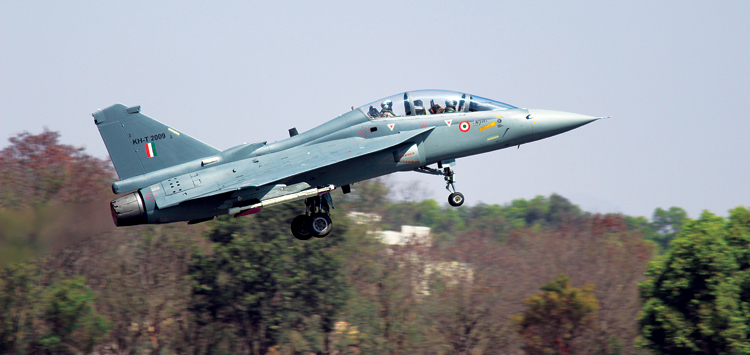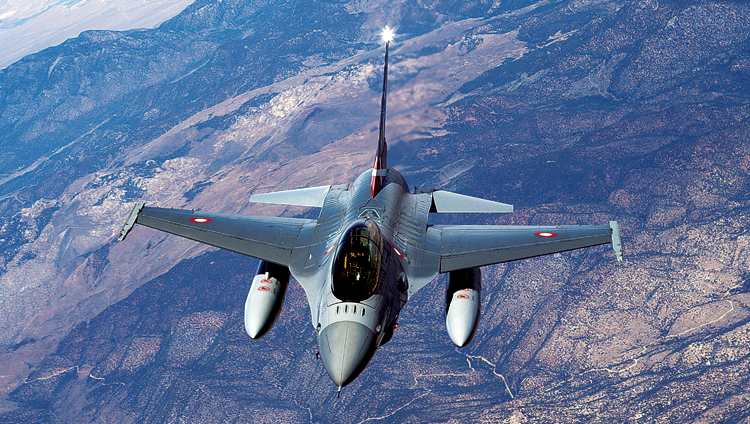INDIAN ARMED FORCES CHIEFS ON
OUR RELENTLESS AND FOCUSED PUBLISHING EFFORTS

SP Guide Publications puts forth a well compiled articulation of issues, pursuits and accomplishments of the Indian Army, over the years

I am confident that SP Guide Publications would continue to inform, inspire and influence.

My compliments to SP Guide Publications for informative and credible reportage on contemporary aerospace issues over the past six decades.
Slow Revamp
The latest blow to the IAF is the abandonment of a two-year-old plan to produce single-engine fighters in large numbers indigenously with foreign collaboration under the ‘Make in India’ initiative

In the recent past, hopes of the Indian Air Force (IAF) of arresting the precipitous drop in the strength of its combat fleet have been dashed yet again. The service has long been assured that “action is in hand” to attain its sanctioned strength of 42 squadrons by 2032, but achievement of that goal now appears impossible. As is well known, the figure of 42 combat squadrons, each consisting of 18 to 20 aircraft, is the assessed minimum the IAF requires to engage China and Pakistan in a putative two-front conflict. Even as the IAF’s numbers plunge, the People’s Liberation Army Air Force (PLAAF) of China is rapidly expanding and modernising. The Pakistan Air Force is also upgrading and at some point in time, could conceivably cross the IAF’s strength numerically, though the IAF would continue to enjoy a qualitative edge.
The latest blow to the IAF’s punch is the apparent abandonment by the government of a two-year-old plan to produce single-engine fighters in large numbers indigenously with foreign collaboration under the ‘Make in India’ initiative. The frontrunners were Lockheed Martin of the United States with the F-16 Block 70 and Saab of Sweden with its JAS 39 Gripen E. However, the Ministry of Defence (MoD) apparently wants to expand the competition to twin-engine jets, including Boeing’s F/A-18 Super Hornet, since the F-18E variant is a strong contender for the Indian Navy’s impending contract for 57 carrier-based fighters. The IAF is reportedly struggling to formulate an approach in line with the MoD’s sudden change of heart which has more to do with politics than logic or operational imperatives.
STATE OF PLAY
How many squadrons does the IAF have? On paper, 32 of which 15 squadrons of the Sukhoi Su-30MKI totalling 272 aircraft will be the mainstay for the foreseeable future. But since the last ten squadrons of legacy MiG-21s and MiG-27s are due to be retired by 2022, the number will plunge to 22 by 2022, and then decrease more gradually to 19 squadrons by 2027 and 16 by 2032. The only way to revamp the IAF’s combat fleet therefore is to induct new aircraft.
This situation has not developed overnight. Aircraft have a specified Total Technical Life (TTL) which can to some extent, be prolonged by upgrades and the emerging shortage of fighters has been predicted since the turn of the century. The selection of new platforms depends on various operational, strategic and financial considerations; but the sticking point is often the government’s requirement for technology transfer and industrial cooperation. No country cheerfully parts with advanced military technology. After all, why would anyone want to encourage competition? HAL has striven for decades to acquire technology from the Russians in return for huge licensed production deals, but has obtained precious little.
Although the IAF initiated a case to induct 126 aircraft or six squadrons of Medium Multi-role Combat Aircraft (MMRCA) in 2002, the tender was only issued in August 2007. Following extensive flight-testing and technical evaluation of the six aircraft competing for the $10 billion deal, the IAF identified the twin-engine Dassault Rafale as the preferred platform. However, after another eight years of effort, the tender was cancelled in 2015 and replaced by a government-to-government deal for just 36 Rafale jets off the shelf. The MoD which now wants the IAF to consider twin-engine jets, had under then Defence Minister Manohar Parrikar, decided that the IAF should first induct single-engine fighters. This made sense because single-engine jets come cheaper and are less expensive to operate than the somewhat more capable twin-engine type.
SELECTION SEQUENCING
The next few months may see the MoD issue yet another Request for Information (RFI) for foreign manufactured fighters followed by a Request for Proposal (RFP). Thereafter it is likely to take four to six years to ink the deal and a decade or more before all the contracted aircraft are delivered.
It is still unclear if there will be another lengthy process of bidding, evaluation, and elimination before the final choice. Will the same six contenders of the 2007 MMRCA shootout feature this time too? They included the Mikoyan MiG-35, the Saab JAS 39 Gripen, the Dassault Rafale, the Eurofighter Typhoon, the Lockheed Martin F-16 and the Boeing F/A-18. Since these have already been exhaustively evaluated by the IAF and the Rafale emerged the clear winner, the needle of selection could veer towards it once again. The Typhoon came in a close second, while the Gripen promises value for money. The Super Hornet is worth considering only because of its commonality with the Navy’s potential choice. But this would amount to the tail wagging the dog.
Another suggestion is to induct additional Su-30MKI jets to remedy the shortfall. This must be rejected due to the exceedingly poor maintainability of the fleet. Besides, the IAF needs a judicious mix of medium and light jets and more Su-30s would skew the balance. Another proposal to opt for the fifth-generation Lockheed Martin F-35A Lightning II may be good for the future; but since well over 3,000 F-35s are already on order, the IAF will not get anything for the next 10-12 years. Besides ‘Make in India’ and technology transfer will have to be completely abandoned.
Ultimately, it is practically a foregone conclusion that capability would again dictate a twin-engine jet while cost would point to a single-engine platform. Hence the latest move will merely result in further delays and is very likely to fail. Since the final choice will probably be political anyway, why not opt for a quick government-to-government deal?
TEJAS TIMELINE
The IAF has long known that it cannot indefinitely count on prohibitively expensive aircraft from foreign sources and would have been greatly pleased to induct indigenous jets – provided they were combat worthy and produced in sufficient numbers. The inability of the Aeronautical Development Agency (ADA) and the Hindustan Aeronautics Limited (HAL) to deliver on these two essentials is therefore partly responsible for the current deficit of IAF combat aircraft. The single-engine Light Combat Aircraft (LCA) Tejas for which the IAF submitted Air Staff Requirements (ASR) in October 1985, first flew in 2001. Although it attained Initial Operational Capability (IOC) in 2011 it is still not fully operational. It may attain this crucial milestone this year.

The IAF’s rather visible lack of enthusiasm for the Tejas Mk 1 stems from the fact that the jet is fitted with the General Electric F404-GE-IN20 turbofan which leaves it significantly underpowered. It also has far less endurance and weapon-carrying capacity compared to fighters such as the Gripen E and the F-16 Block 70. Following considerable pressure from the government, the IAF placed orders for two squadrons of Tejas Mk 1 and is finalising a contract for four squadrons of Tejas Mk 1A, totalling 123 aircraft. The Mk 1A is a somewhat advanced variant with 59 improvements including active electronically scanned array (AESA) radar, inflight refuelling, beyond visual range (BVR) missiles and advanced electronic warfare (EW) capability. HAL currently builds just eight Tejas per year and even taking into account its plans to set up a second production line, the delivery of these 123 jets could stretch beyond 2025.
Years of dithering over new combat aircraft is leading to an impossible situation where the IAF may be hardpressed even to fight with a single adversary, leave alone two
The IAF is keener on the Tejas Mk 2 with its enhanced avionics and radar, besides increased fuel and weapons carrying capacity. However, the more powerful F414-GE-400 engine planned for it may entail considerable redesign of the airframe and a long development and testing period. A final design is expected only by end-2018 and the Tejas Mk 2 may enter production in 2027 or later. The IAF has tentatively agreed to induct 201 of these fighters, if they meet its expectations. If so, the total Tejas fleet would amount to 18 squadrons. However, this would still leave a gap of eight to ten squadrons.
TWISTS AND TURNS
If only the LCA Tejas had been produced according to its promised schedule and capability, a large portion of the IAF combat fleet would by now, have been indigenous and there would have been no shortfall. The government is trying to double Tejas production by involving the private sector, but it is slow going. It is heartening that both the MoD and the IAF have expressed full backing for the Tejas programme; but words now need to be translated into firm action, in particular as regards speedily making the Tejas Mk 1A operational and expediting its production. Tejas Mk 2 development too needs to be strictly time bound, lest it meander endlessly as has been the case with the Tejas Mk 1. Meanwhile, about 11 squadrons of older Jaguar, Mirage 2000 and MiG-29 aircraft are either undergoing or are planned for upgrade programmes. These revamped jets should remain operational till around 2030.

Years of dithering over new combat aircraft is fast leading to an impossible situation where the IAF may be hard-pressed even to fight with a single adversary, leave alone two. The large shortfall in budget allocations for capital acquisition by the military, with the IAF getting less than half of its projected demands for FY 2018-19, is not reassuring. The IAF must get the aircraft best suited to its operational imperatives and that is unlikely to be the cheapest option. However, a decision on new jets can now be expected only after the installation of a new government following general elections due next year.
The IAF’s operational capability must not be allowed to deteriorate any further. One step that should be taken immediately is to double the existing order of 36 Rafale jets because till HAL delivers, there’s no escaping the need for inducting foreign manufactured aircraft. In the interim, the IAF can expect more twists and turns before it comes within sniffing distance of the couple of hundred or so combat aircraft it so desperately needs.





